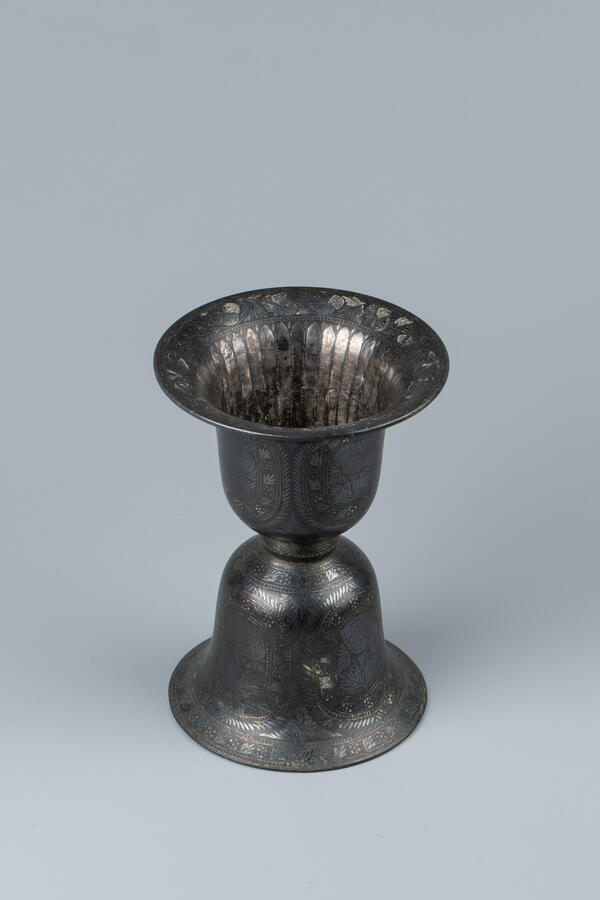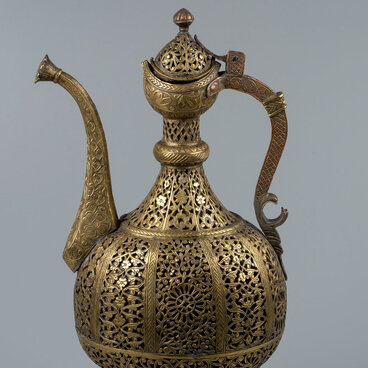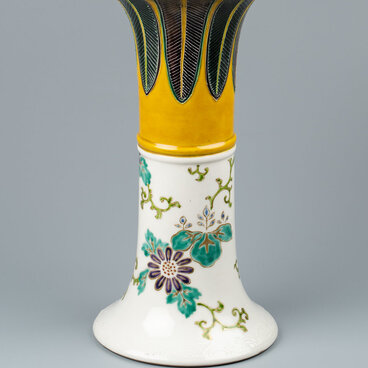The Samara Regional Art Museum houses items made in various metalworking techniques: damascening, engraving, coining and inlaying. However, the most fascinating exhibits are bidri vessels — examples of the ancient Indian handicraft.
One of them is a spittoon, a vessel for spitting into, completely covered with vegetal ornaments. When going out, an Indian or Ceylonese takes with them betel (a material for chewing gum) and carries it in special pouches — woven ones in Ceylon, or metal in Southern and Northern India. If they are rich, then the servant carries behind them a metal box with compartments for betel. Chewing of betel causes copious salivary secretion of a blood-red color. Therefore, in India, the spittoon occupies a very honorable place and is often decorated with intricate patterns.
The bidriware art originated seven centuries ago, when Sultan Ahmad Shah (ruled from 1422 to 1436) invited skilled coiners from Iran to his new capital Bidar. Persian craftsmen brought uncharacteristic patterns and technologies to South India. This is how a new way of metal processing and silver inlaying appeared — the wonderful Persian-Indian art of bidri.
The peculiarity of bidriware is the combination of a matte black surface with patterned inlay with silver and gold. The center of bidriware production was the city of Bidar near Hyderabad. Nowadays, the material for bidriware is no longer kept secret. It is simply an alloy of zinc and copper: for 16 parts of zinc 1 part of copper. Copper is added to make the workpiece pliable and better and easier to polish. Figurines and dishes are cast from such an alloy. They develop a gray color at first. Then, after adding copper sulfate on the cooled metal, the gray color turns into black. The design is engraved by making grooves in the metal. After that, carefully working with a small hammer, a strip of silver is hammered into the grooves, which creates silver patterns on the smooth surface. The main secret of bidriware is that the item is polished and rubbed with a paste made of Bidar soil. At the end of the process, the finished object is polished again for shine, only not with the paste, but with a soft cloth soaked in coconut oil. In Indian applied arts, inlaying with non-ferrous and precious metals, ivory and mother-of-pearl has reached extraordinary levels of artistry.
One of them is a spittoon, a vessel for spitting into, completely covered with vegetal ornaments. When going out, an Indian or Ceylonese takes with them betel (a material for chewing gum) and carries it in special pouches — woven ones in Ceylon, or metal in Southern and Northern India. If they are rich, then the servant carries behind them a metal box with compartments for betel. Chewing of betel causes copious salivary secretion of a blood-red color. Therefore, in India, the spittoon occupies a very honorable place and is often decorated with intricate patterns.
The bidriware art originated seven centuries ago, when Sultan Ahmad Shah (ruled from 1422 to 1436) invited skilled coiners from Iran to his new capital Bidar. Persian craftsmen brought uncharacteristic patterns and technologies to South India. This is how a new way of metal processing and silver inlaying appeared — the wonderful Persian-Indian art of bidri.
The peculiarity of bidriware is the combination of a matte black surface with patterned inlay with silver and gold. The center of bidriware production was the city of Bidar near Hyderabad. Nowadays, the material for bidriware is no longer kept secret. It is simply an alloy of zinc and copper: for 16 parts of zinc 1 part of copper. Copper is added to make the workpiece pliable and better and easier to polish. Figurines and dishes are cast from such an alloy. They develop a gray color at first. Then, after adding copper sulfate on the cooled metal, the gray color turns into black. The design is engraved by making grooves in the metal. After that, carefully working with a small hammer, a strip of silver is hammered into the grooves, which creates silver patterns on the smooth surface. The main secret of bidriware is that the item is polished and rubbed with a paste made of Bidar soil. At the end of the process, the finished object is polished again for shine, only not with the paste, but with a soft cloth soaked in coconut oil. In Indian applied arts, inlaying with non-ferrous and precious metals, ivory and mother-of-pearl has reached extraordinary levels of artistry.






